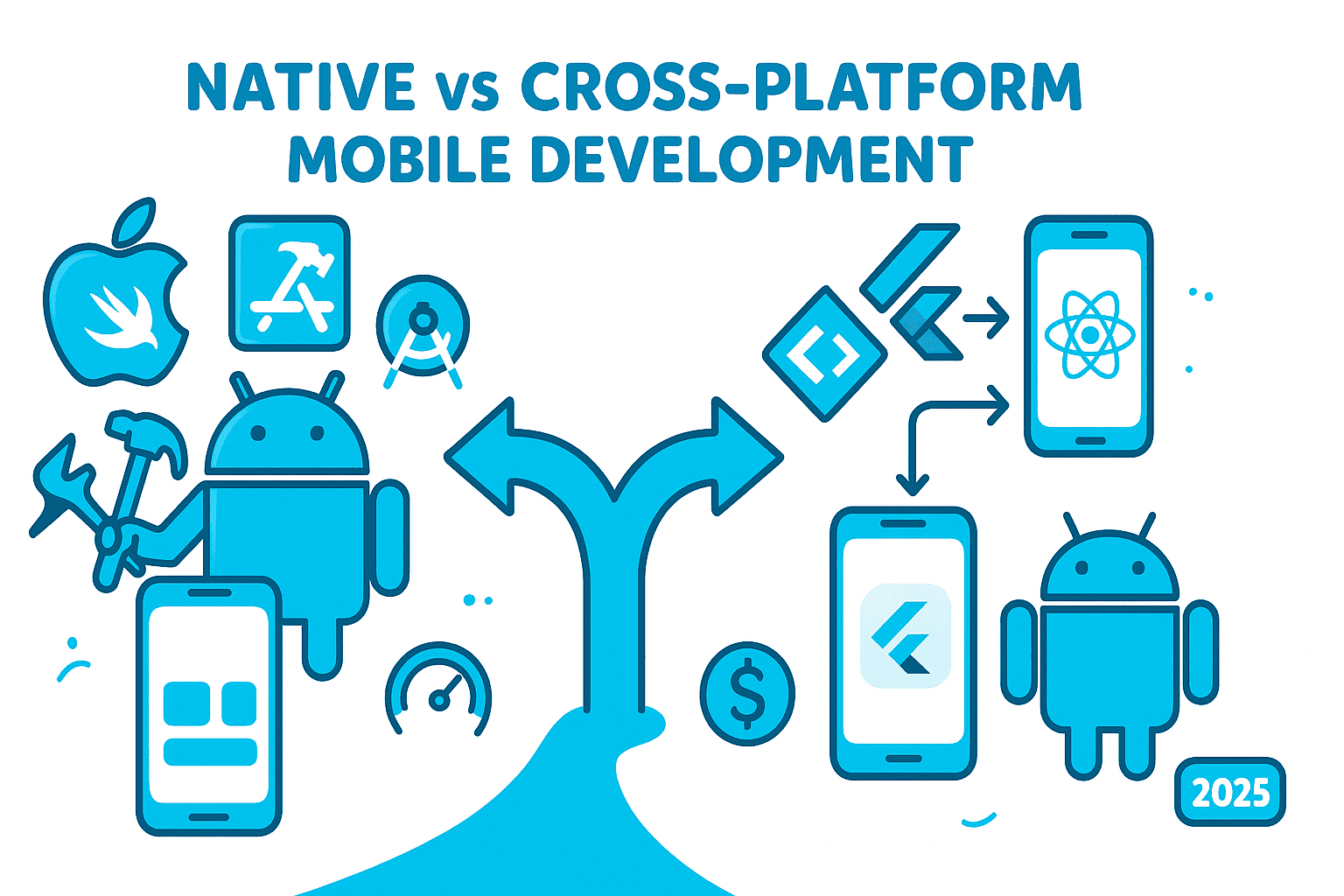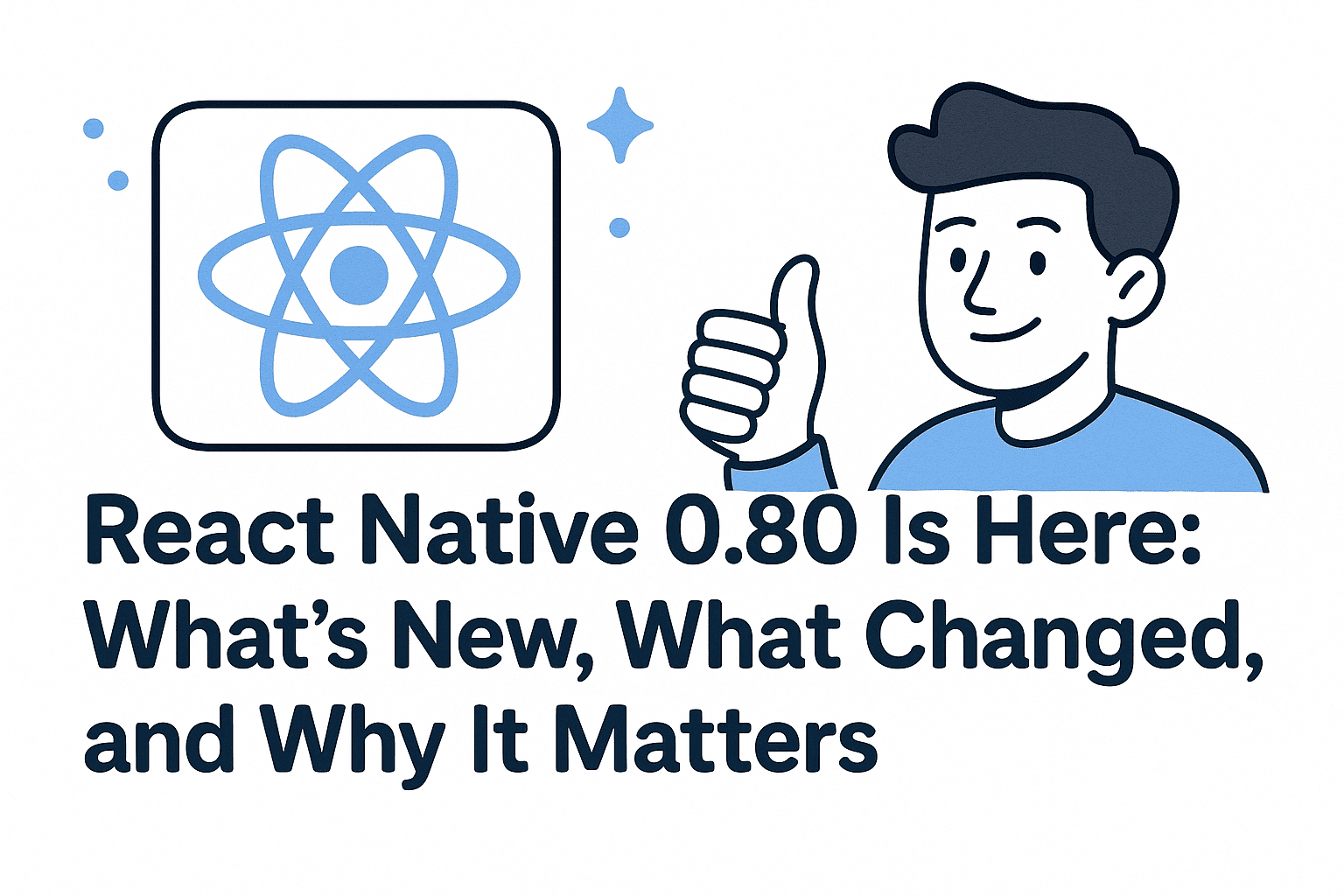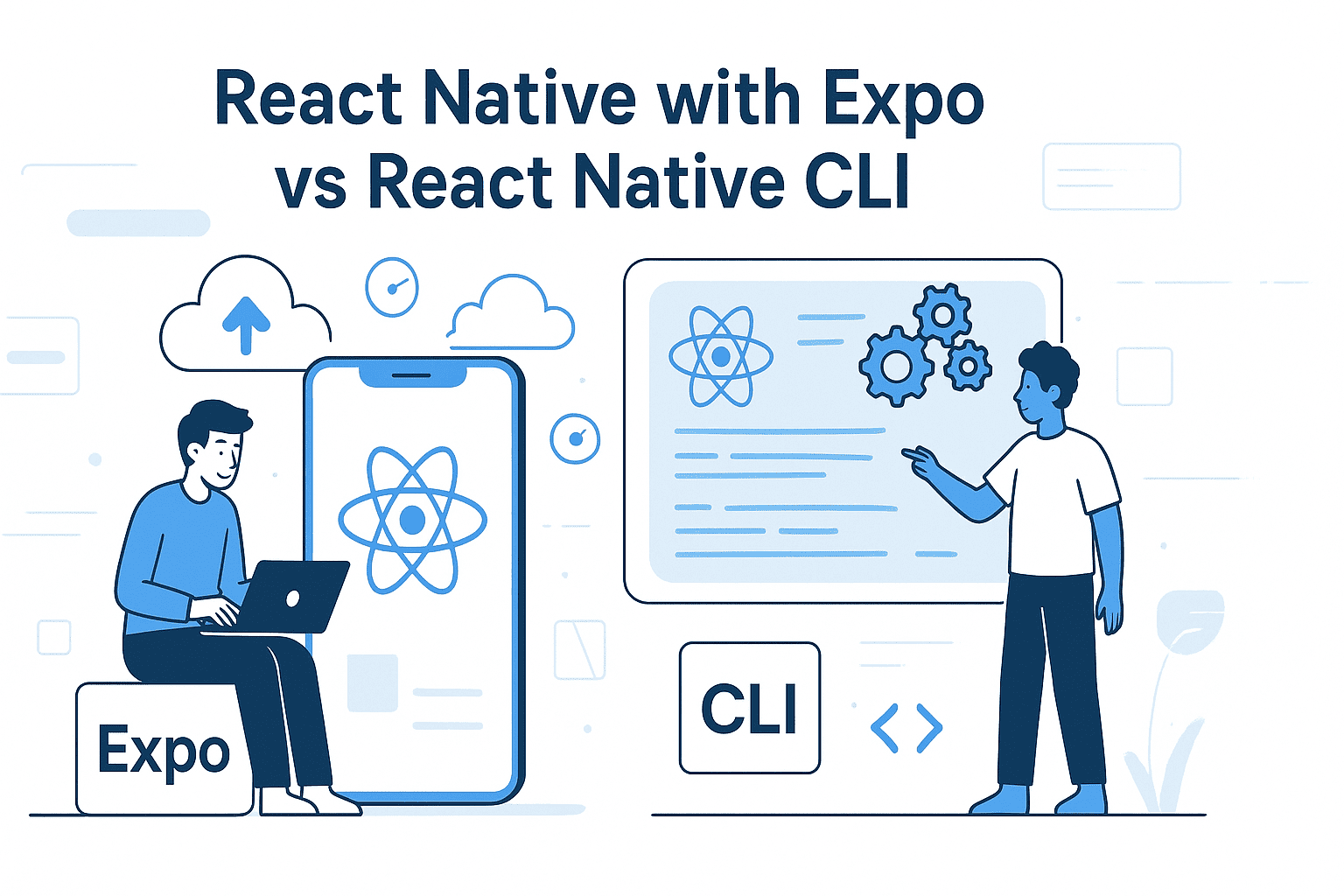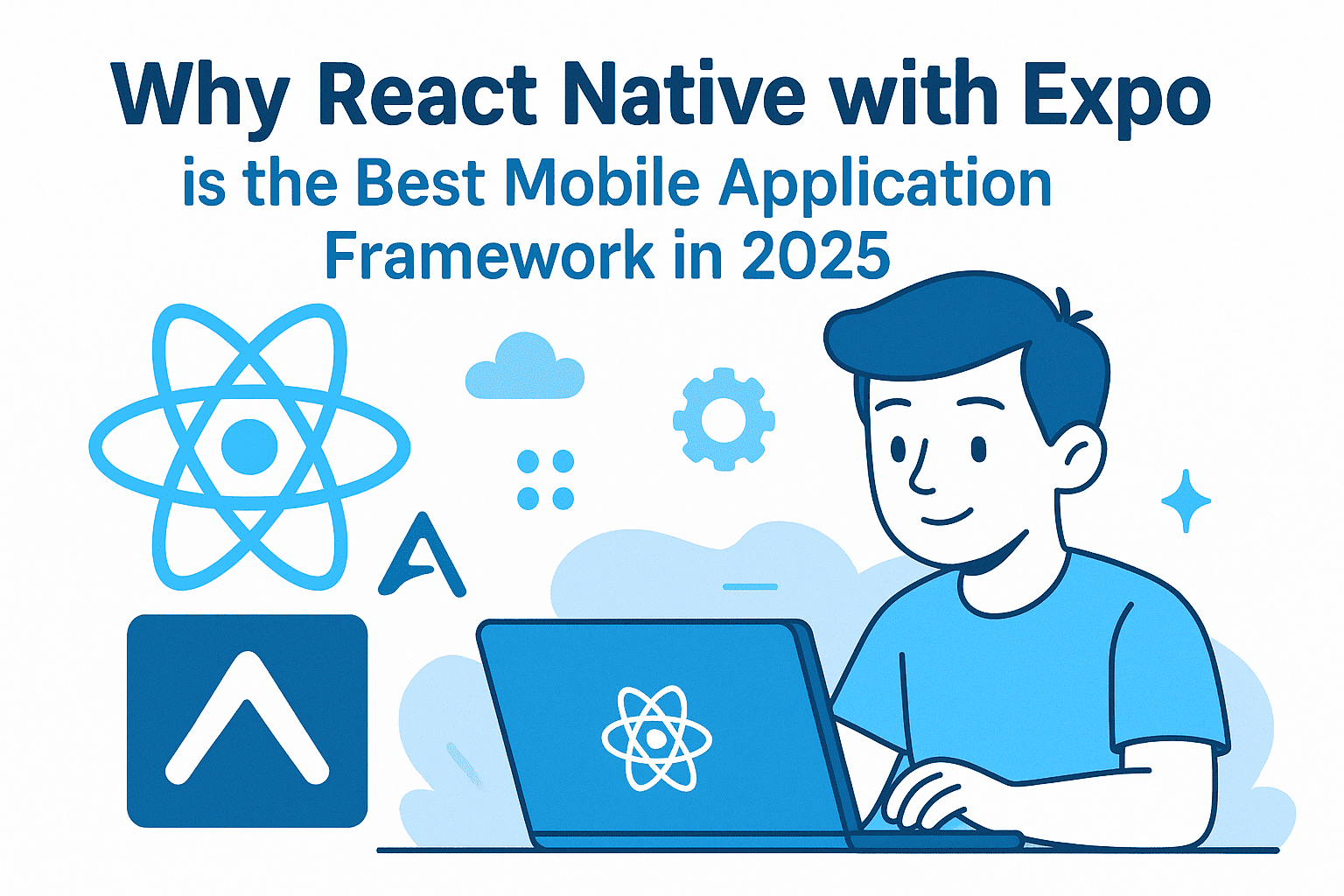The Mobile Development Decision That Will Make or Break Your Project
Choosing between native and cross-platform mobile development isn't just a technical decision it's a strategic one that affects your budget, timeline, user experience, and long-term maintenance costs. After years of building mobile applications for startups and enterprises alike, I've helped dozens of clients navigate this critical choice.
In this comprehensive guide, I'll break down exactly when to choose native development, when cross-platform makes sense, and how to make the right decision for your specific situation in 2025.
Understanding the Landscape: Native vs Cross-Platform
What is Native Mobile Development?
Native development means building separate applications for each platform using platform-specific languages and tools:
- iOS: Swift or Objective-C with Xcode
- Android: Kotlin or Java with Android Studio
Each app is built specifically for its platform, leveraging native APIs and UI components directly.
What is Cross-Platform Development?
Cross-platform development allows you to write code once and deploy to multiple platforms. The leading frameworks in 2025 are:
- React Native (JavaScript/TypeScript)
- Flutter (Dart)
- .NET MAUI (C#)
- Ionic (JavaScript/TypeScript with web technologies)
When to Choose Native Development: Real-World Scenarios
Scenario 1: Performance-Critical Applications
Example: A high-performance fitness app with real-time motion tracking
I recently worked with a fitness tech startup building an app that required:
- Real-time accelerometer and gyroscope data processing
- Complex 3D visualizations of workout movements
- Integration with Apple Watch and Wear OS devices
- Low-latency audio feedback
Why Native Won: The app needed direct access to hardware sensors with zero performance overhead. Native development provided:
- Maximum CPU and GPU efficiency
- Direct access to platform-specific fitness frameworks (HealthKit, Google Fit)
- Smooth 60 FPS animations even during intensive calculations
- Better battery optimization
Result: 95% user satisfaction rating with consistent 4.8+ app store ratings for performance.
Scenario 2: Platform-Specific Features are Core to Your App
Example: A mobile banking app with biometric authentication
When building a fintech application, certain features are deeply integrated into each platform:
- Face ID and Touch ID on iOS
- Advanced camera APIs for check deposits
- Secure Enclave integration for cryptographic operations
- Platform-specific accessibility features
Why Native Won: Security-critical applications benefit from:
- Direct access to platform security frameworks
- Faster adoption of new OS security features
- Better compliance with financial regulations
- No abstraction layer that could introduce vulnerabilities
Scenario 3: You Need the Absolute Best User Experience
Example: A premium photo editing app competing with Apple Photos
Users expect apps to feel completely native to their platform:
- iOS users expect gestures, animations, and transitions that follow Apple's Human Interface Guidelines
- Android users expect Material Design principles and Android-specific navigation patterns
Why Native Won:
- Platform-specific UI components automatically follow design guidelines
- Haptic feedback and system sounds feel natural
- Transitions and animations match system apps
- Edge cases and platform quirks are handled by default
When to Choose Cross-Platform Development: Strategic Choices
Scenario 1: Rapid Market Validation with Limited Budget
Example: A social networking app for a specific niche community
A client came to me with a unique social platform idea for book clubs. They had:
- Limited budget ($40,000)
- 3-month deadline to launch
- Need for both iOS and Android presence
- Uncertain product-market fit
Why Cross-Platform Won: Using React Native, we:
- Shared 85% of the codebase between platforms
- Launched simultaneously on both app stores
- Reduced development costs by 60% compared to native
- Iterated quickly based on user feedback
Result: App reached 10,000 users in first month, validated the concept, and secured Series A funding for further development.
Scenario 2: Business/Productivity Apps with Standard UI
Example: An enterprise task management and collaboration tool
For business applications that don't require cutting-edge features:
- Standard forms, lists, and navigation
- API-driven data display
- Push notifications
- File uploads and downloads
- Authentication and user management
Why Cross-Platform Won: Flutter provided:
- Beautiful, consistent UI across platforms
- Fast development of CRUD operations
- Easy integration with RESTful APIs and GraphQL
- Single codebase for web admin panel and mobile apps
- Significantly reduced maintenance overhead
ROI: Client saved approximately $8,000 per month in maintenance costs compared to maintaining two native codebases.
Scenario 3: Content-Driven Applications
Example: A news and media consumption app
For applications primarily focused on content delivery:
- News readers
- Blogs and article platforms
- Podcast players
- Video streaming apps (without complex video processing)
Why Cross-Platform Won: React Native with TypeScript offered:
- Rapid UI development with reusable components
- Excellent performance for list-based interfaces
- Strong ecosystem for media playback
- Hot reloading for faster development cycles
- Ability to share business logic with web version
Scenario 4: MVP Development with Future Flexibility
Example: A marketplace app connecting local service providers
When you need to move fast but want the option to go native later:
Why Cross-Platform Won:
- Launched in 2 months instead of 4-5 months
- Validated business model with real users
- Used Flutter for near-native performance
- Maintained flexibility to rewrite specific modules natively if needed
- 70% code reuse even if partially switching to native later
The Hybrid Approach: Best of Both Worlds
When to Use a Mixed Strategy
In my experience, some of the most successful projects use a hybrid approach:
Example: A ride-sharing app (similar to Uber/Lyft)
- Native components:
- Real-time GPS tracking and mapping (native iOS/Android)
- Payment processing with platform wallets
- Background location services
- Cross-platform components:
- User authentication and profile management (Flutter)
- Ride history and receipts (Flutter)
- Customer support chat (Flutter)
- Settings and preferences (Flutter)
Result: 65% code sharing while maintaining native performance for critical features.
Decision Framework: How to Choose for Your Project
Based on my experience consulting with 50+ clients, here's my decision framework:
Choose Native If
- Your app is performance-intensive (gaming, AR/VR, real-time processing)
- You require cutting-edge platform-specific features
- User experience is your primary competitive advantage
- You have the budget for separate iOS and Android teams
- App store review guidelines favor native (Apple sometimes scrutinizes cross-platform apps)
- You're building for a single platform initially
- Your app handles sensitive data requiring maximum security
Choose Cross-Platform If
- You need to launch quickly on both platforms
- Your budget is constrained (typically 40-60% cost savings)
- Your app is primarily CRUD or content-driven
- You have limited mobile development resources
- You need to maintain feature parity across platforms
- Your app doesn't require intensive hardware integration
- You want to share code with a web application
- You're building an MVP to test market demand
The 2025 State of Cross-Platform Frameworks
Flutter (My Recommendation for Most Projects)
Strengths:
- Exceptional UI performance with Skia rendering engine
- Beautiful, customizable widgets
- Strong typing with Dart
- Excellent documentation and growing ecosystem
- Google's backing and active development
Best For: Apps requiring custom UI, animation-heavy applications, startups needing rapid development
Client Success Story: Built a real estate listing app with complex filters, maps, and photo galleries in 10 weeks. Performance matches native apps.
React Native (Best for JavaScript Teams)
Strengths:
- Massive ecosystem and community
- Leverage existing JavaScript/React developers
- Code sharing with React web apps
- Mature framework with proven track record
- Excellent third-party libraries
Best For: Teams with React experience, apps needing extensive third-party integrations
Client Success Story: E-commerce app with 100,000+ active users, 80% code sharing with web platform.
.NET MAUI (Best for Enterprise .NET Shops)
Strengths:
- Ideal for organizations already invested in Microsoft ecosystem
- Strong enterprise support and tooling
- Single codebase for mobile, desktop, and web
- Excellent Visual Studio integration
Best For: Enterprise applications, teams with C# expertise
Cost Analysis: What to Expect in 2025
Native Development Investment
Small App (3-4 months):
- iOS: $50,000 - $80,000
- Android: $50,000 - $80,000
- Total: $100,000 - $160,000
Medium Complexity (6-8 months):
- iOS: $100,000 - $150,000
- Android: $100,000 - $150,000
- Total: $200,000 - $300,000
Ongoing Maintenance: $5,000 - $15,000/month
Cross-Platform Development Investment
Small App (2-3 months):
- Both platforms: $40,000 - $60,000
- Savings: 50-60%
Medium Complexity (4-5 months):
- Both platforms: $80,000 - $120,000
- Savings: 50-60%
Ongoing Maintenance: $3,000 - $8,000/month
Note: These are estimates based on my freelance rates and market averages. Actual costs vary by complexity, features, and developer expertise.
Common Myths Debunked
Myth 1: "Cross-platform apps always perform worse"
Reality: Modern frameworks like Flutter and React Native perform excellently for most use cases. I've built cross-platform apps handling 10,000+ items in scrollable lists with smooth 60 FPS performance.
Myth 2: "You can't access native features with cross-platform"
Reality: Both Flutter and React Native provide extensive plugins for native features. When needed, you can write custom native modules. In my projects, 95% of required features are available through existing plugins.
Myth 3: "Cross-platform apps look the same on all platforms"
Reality: Modern frameworks make it easy to implement platform-specific designs. I regularly build apps that follow iOS design on iPhone and Material Design on Android, all from a shared codebase.
Myth 4: "Native is always more expensive"
Reality: For single-platform apps or when you have existing native teams, native can be cost-effective. The multiplier comes when you need both iOS and Android.
My Recommendations Based on Your Situation
You're a Startup with Seed Funding
Recommendation: Flutter or React Native
Why: Validate your idea quickly, iterate based on feedback, and preserve runway. You can always rewrite critical parts natively later if needed.
You're an Enterprise with Existing Mobile Apps
Recommendation: Continue with native, consider cross-platform for new features
Why: Leverage existing expertise, maintain consistency, but experiment with cross-platform for non-critical features.
You're Building a Consumer App Competing on UX
Recommendation: Native development
Why: User experience is your differentiator. Native gives you the polish and performance to stand out.
You're Creating an Internal Business Tool
Recommendation: Cross-platform (Flutter or React Native)
Why: Cost efficiency, rapid deployment, and maintainability matter more than bleeding-edge features.
How I Can Help You Make the Right Choice
As a mobile development consultant and contractor, I've guided companies from idea to app store success. Here's how I work with clients:
Discovery & Strategy Session
- Analyze your specific requirements and constraints
- Provide honest recommendations based on your goals
- Create a technical roadmap with clear milestones
Development Services
- Native iOS Development: Swift, SwiftUI, UIKit, Core Data
- Native Android Development: Kotlin, Jetpack Compose, Room
- Cross-Platform Development: Flutter, React Native
- Architecture & Code Review: Ensure your existing codebase follows best practices
Flexible Engagement Models
- Project-Based: Fixed scope and timeline
- Hourly Consulting: Strategic guidance and code reviews
- Ongoing Retainer: Long-term development partnership
Real Results from Recent Projects
Case Study 1: E-Learning Platform (Flutter)
- Timeline: 12 weeks from concept to app store
- Platforms: iOS, Android, Web
- Code Sharing: 92%
- User Rating: 4.7/5 stars (combined)
- Client Savings: $85,000 vs native approach
Case Study 2: Healthcare App (Native Swift)
- Timeline: 16 weeks for iOS only
- Integration: HealthKit, CareKit, ResearchKit
- Performance: Real-time vital signs monitoring
- Compliance: HIPAA compliant
- User Satisfaction: 4.9/5 stars
Case Study 3: Social Commerce App (React Native)
- Timeline: 14 weeks for both platforms
- Scale: 50,000+ active users
- Performance: 99.8% crash-free rate
- Maintenance: 60% reduction in ongoing costs
The Future: Where Mobile Development is Heading in 2025
Emerging Trends to Watch
- AI Integration: Native frameworks getting first-class ML features, but cross-platform catching up quickly
- Kotlin Multiplatform: Emerging as a serious contender for code sharing
- WebAssembly in Mobile: Potential game-changer for cross-platform development
- Foldables & New Form Factors: Native might have temporary advantages for cutting-edge devices
My Prediction
Cross-platform frameworks will continue narrowing the gap with native development. By end of 2025, I expect:
- 70% of new business apps will use cross-platform frameworks
- Native development will dominate gaming, AR/VR, and performance-critical apps
- Hybrid approaches will become standard for complex applications
Making Your Decision: A Quick Checklist
Before your next mobile project, answer these questions:
Budget & Timeline
- [ ] Do I need both iOS and Android simultaneously?
- [ ] Is my timeline under 4 months?
- [ ] Is my budget under $100,000?
Technical Requirements
- [ ] Does my app need intensive 3D graphics or gaming features?
- [ ] Will I use cutting-edge AR/VR capabilities?
- [ ] Do I need real-time hardware sensor processing?
- [ ] Is my app primarily forms, lists, and API data?
Team & Resources
- [ ] Do I have separate iOS and Android developers?
- [ ] Do I have JavaScript/TypeScript or Dart experience?
- [ ] How important is long-term maintainability?
Business Goals
- [ ] Am I validating an MVP?
- [ ] Is user experience my primary differentiator?
- [ ] Do I need to iterate quickly based on feedback?
- [ ] What's my 2-year product roadmap?
If you answered "yes" to most questions in Budget & Timeline and "no" to most in Technical Requirements, cross-platform is likely your best choice.
If technical requirements demand cutting-edge features and UX is your competitive advantage, native development is the way to go.
Let's Build Something Amazing Together
Choosing between native and cross-platform development is just the first step. Successful mobile apps require:
- Strategic planning and architecture
- Clean, maintainable code
- Rigorous testing and quality assurance
- Thoughtful UX design
- Performance optimization
- Ongoing maintenance and updates
I've helped companies launch successful mobile applications across industries including fintech, healthcare, e-commerce, social networking, and enterprise software.
Frequently Asked Questions
Can I start with cross-platform and migrate to native later?
Yes, and I've helped several clients do this successfully. Start with cross-platform to validate your market, then migrate performance-critical features to native while maintaining the rest in cross-platform. This hybrid approach is often the most cost-effective strategy.
How do I choose between Flutter and React Native?
Choose Flutter if: You want excellent performance, custom UI, and don't have existing React expertise.
Choose React Native if: You have React developers, need extensive third-party integrations, or want to share code with a React web app.
I'm proficient in both and can help you decide based on your specific situation.
What about Kotlin Multiplatform Mobile (KMM)?
KMM is promising but still maturing. It's best for teams already using Kotlin and wanting to share business logic while keeping native UIs. In 2025, Flutter and React Native still have more robust ecosystems for most projects.
How do cross-platform apps handle OS updates?
Modern frameworks like Flutter and React Native are quick to support new OS features. Critical updates are usually available within weeks of OS releases. For most apps, this timing is perfectly acceptable.
What's the performance difference in real numbers?
In my benchmarks:
- Native: Consistent 60 FPS for complex animations
- Flutter: 55-60 FPS for the same operations (imperceptible to users)
- React Native: 50-60 FPS depending on implementation
For 95% of applications, users won't notice the difference.
Ready to discuss your mobile app project?
Whether you need
- Strategic consultation on technology choices
- End-to-end app development
- Code review and optimization of existing apps
- Rescue mission for troubled projects
- Staff augmentation for your development team
I offer flexible engagement models tailored to your needs and budget.
Reach out
📧 Email: safi.abdulkader@gmail.com | 💻 LinkedIn: @abdulkader-safi | 📱 Instagram: @abdulkader.safi | 🏢 DSRPT
Drop me a line, I’m always happy to collaborate! 🚀



